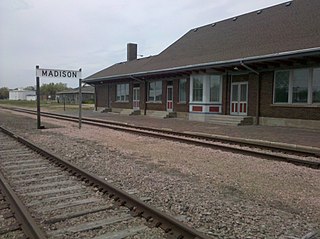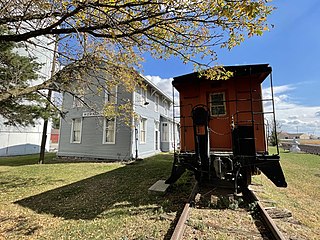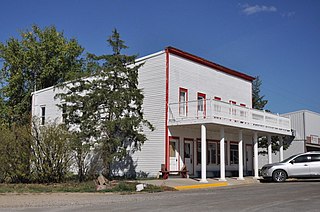
La Crosse station is an Amtrak intercity train station in La Crosse, Wisconsin, served the daily Empire Builder. The station was built in 1926–27 by the Chicago, Milwaukee, St. Paul, and Pacific Railroad, replacing an older station that burned in 1916. The station was listed on the National Register of Historic Places as the Chicago, Milwaukee and St. Paul Railway Depot and was renovated in 2001.

The Chicago, Milwaukee, St. Paul and Pacific Railroad South Cle Elum Rail Yard located in South Cle Elum, Washington, was a division point on the Chicago, Milwaukee, St. Paul and Pacific Railroad's Coast Division. It was established by the railroad in 1909 during construction of its "Pacific Extension".

The Chicago, Milwaukee, St. Paul and Pacific Depot in Clinton, Minnesota, United States, is a historic railway station. It is now known as the Clinton Depot, and serves as a local history museum for the Clinton area. It was added to the National Register of Historic Places in 1985. The interior has hardwood floors and decorative wainscoting in the waiting room, an office in the middle and a freight room at the south end. Exhibits include military memorabilia, farm and agriculture displays, train memorabilia, and photos, posters, newspapers and historic items about Clinton.

The Milwaukee Railroad Depot in Alberton, Montana was built by the Chicago, Milwaukee, St. Paul and Pacific Railroad in 1908, during its Pacific Extension from Chicago, Illinois to Tacoma, Washington from 1906 to 1909. The depot is a rectangular one-story wood-frame building constructed in the Craftsman style.

The Chicago, Milwaukee, St. Paul and Pacific Railroad Depot in Aberdeen, South Dakota was built by the Chicago, Milwaukee, St. Paul and Pacific Railroad in 1911.

The Milwaukee Road Freight House in Rapid City, South Dakota, United States, was built by the Chicago, Milwaukee, St. Paul and Pacific Railroad in 1923 to store and ship freight. The building is single storey, rectangular, and constructed of brick. Offices were placed at one end with warehouse space occupying the rest of the building. Large freight doors and bays are along each side. The circa 1915 depot is located east of the freight house.

The Chicago, Milwaukee, St. Paul and Pacific Railroad Depot and Lunchroom are two buildings located in Wells, Minnesota, and built by the Chicago, Milwaukee, St. Paul and Pacific Railroad in 1903.

The Chicago, Milwaukee and St. Paul Depot in Yankton, South Dakota was built in 1905 by the Chicago, Milwaukee, St. Paul and Pacific Railroad.

The Chicago, Milwaukee, St. Paul and Pacific Railroad Depot was built by the Chicago, Milwaukee, St. Paul and Pacific Railroad in 1906. It is located at the south end of the business district in Madison, South Dakota. The building is a rectangular single-story brick structure. It housed men's and women's waiting rooms, a lunch room ("beanery"), station agent's office, and a freight room. Rather than being a wood-frame building, as was usual for smaller, rural stations, the depot at Madison was built of brick.
Chicago, Milwaukee, St. Paul and Pacific Railroad Depot may refer to:
Frost & Granger was an American architectural partnership from 1898 to 1910 of brothers-in-law Charles Sumner Frost (1856–1931) and Alfred Hoyt Granger (1867–1939). Frost and Granger were known for their designs of train stations and terminals, including the now-demolished Chicago and North Western Terminal, in Chicago. The firm designed several residences in Hyde Park, Illinois, and many other buildings. Several of their buildings are listed on the U.S. National Register of Historic Places.

The Chicago, Milwaukee & St. Paul Depot-Jefferson, also known simply as the Milwaukee Depot is an historic building located in Jefferson, Iowa, United States. The rail line that this station served was built by the Wabash, St. Louis and Pacific Railway in either 1882 or 1883. It was part of the 500 miles (800 km) of track developed by Jay Gould in Iowa. Known as the High Bridge Route because of the height of the bridge over the Des Moines River, it was acquired by the Des Moines, Northern and Western Railroad in 1891. Four years later the Chicago, Milwaukee and St. Paul Railway acquired the line. The Milwaukee Road built this train station from their standard building plan between 1906 and 1909. It is almost identical to the station built in 1906 in Adel, Iowa. This passenger station replaced a combination passenger and freight depot that was moved and used solely as a freight depot. The Milwaukee Road discontinued passenger service in Jefferson in the early 1950s, and the depot continued as a freight office until 1980. The building was listed on the National Register of Historic Places in 1994.
The Klondike Hotel, also known as the Park Hotel, is a historic building located in Manilla, Iowa, United States. The economic fortunes of Manilla rose and fell with the Chicago, Milwaukee, St. Paul and Pacific Railroad. The two-story, frame, Italianate style hotel was built by H.J. Kopak in 1897. F.M. Offineer was its first owner. The building features a hipped roof, bracketed eaves, and a full-length front porch. It was built a block away from the Milwaukee depot. It served both passengers and crews from trains that had an overnight layover in Manilla. In the early 20th-century Manilla became the junction on the Milwaukee's mainline across Iowa where trains continued on to Omaha or on to the Pacific extension through South Dakota and across the American West. The hotel's name was changed to the Park Hotel in 1903, and an addition was built onto the rear of the hotel in 1905. It went through a succession of owners, and its financial success was dependent on the business brought to it by the railroad. The hotel was listed on the National Register of Historic Places in 1996.
Joel U. Nettenstrom was an American architect employed as a staff architect in the Bridge and Building Department of the Chicago, Milwaukee, St. Paul and Pacific Railroad. Several of the railroad stations he designed are listed in the National Register of Historic Places (NRHP).

The Calmar Passenger Depot is a historic building located in Calmar, Iowa, United States. It was built by the Chicago, Milwaukee & St. Paul Railroad in 1915 to replace the Depot Hotel that had been destroyed in a fire. The single-story building originally featured a 27 feet (8 m) canopy on its east side that was removed by the railroad in 1970. It was reconstructed in 1998. The passenger trains were on a line that ran between Madison, Wisconsin and South Dakota. They were discontinued in the 1960s. The former depot now houses restrooms for the Prairie Farmer Bike trail, which is adjacent to the building, farmers and flea markets, and other small community events. It was listed on the National Register of Historic Places in 2011.

The Wheaton Depot is a former train station in Wheaton, Minnesota, United States, built circa 1906 to handle both passengers and freight. It was built by the Chicago, Milwaukee & St. Paul Railroad to replace an 1885 depot that had burned down, and remained in service until 1976. It was listed on the National Register of Historic Places in 1985 as the Chicago, Milwaukee and St. Paul Depot for having local significance in the themes of architecture and transportation. It was nominated for being a well-preserved example of an early-20th-century combination depot built on a standard design, and for being the best symbol of the railroad's crucial impact on the community.

The Chicago, Milwaukee, St. Paul & Pacific Combination Depot-Hornick, also known as the Hornick Depot, is a historic building located in Hornick, Iowa, United States. The town was patted by the Chicago, Milwaukee, St. Paul & Pacific Railroad's land company when the railroad created a branch line from Manilla, Iowa to Sioux City. Completed in 1887, the railroad built this two-story frame structure to serve as its passenger and freight depot. It is one of six such depots that remain in Iowa, and the best preserved. These buildings were built from a standard design used by the railroad. The two-story stations included living quarters for the station manager because the towns had yet to develop when the depot was built. This was an island depot, with freight loaded on the north side and passengers boarded on the south. Decorative elements on this depot include lathe-turned wooden finials, angled wooden brackets, and bracketed door and window hoods. Passenger service ended in the 1950s, and grain was loaded here until 1980 when the Milwaukee Road abandoned the Sioux City branch line. The building was listed on the National Register of Historic Places in 1990. It has been converted into a local history museum.

The Pearl Hotel, located on South Main in Kadoka, South Dakota, was built in 1907. It was listed on the National Register of Historic Places in 2007.

Madison station is a former railroad station in Madison, Wisconsin. The station served passenger and freight trains of the Chicago and North Western Railway (C&NW). Passenger service ended in 1965 and the passenger station and freight depot was bought by Madison Gas and Electric (MGE) and has been renovated to serve as offices. The station and freight depot are listed as contributing properties on the National Register of Historic Places East Wilson Street Historic District. The Chicago, Milwaukee, St. Paul and Pacific Railroad had tracks paralleling the C&NW and also had a nearby passenger station that outlasted the C&NW station as an active station by several years.
The Utica Depot was built by the Chicago, Milwaukee and St. Paul Railway in the 1890s. It is a rectangular one story structure with wide overhanging bracketed eaves. It is a standardized depot design constructed by railroads in many rural locations. The depot has belled siding and an irregular stone foundation; a bay window and the main door are located on the front façade.

















